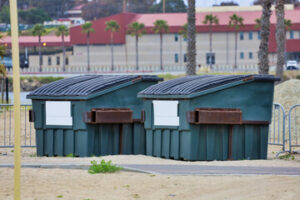Different types of dumpsters serve various waste removal needs. Understanding the differences between these Dumpster Rental In Baltimore MD can help you make a more informed decision on which one is right for your project.

Roll-off dumpsters are rectangular containers with open tops that can be hauled away on a garbage truck. They are often used in construction projects and large home clean-outs. Front-load dumpsters are often found behind businesses that generate regular trash, such as restaurants and offices.
Residential Dumpsters
Dumpsters are essential for managing waste, but the type you need depends on whether you’re a homeowner or a business owner. Understanding the differences between residential and commercial dumpsters helps you select a rental solution that meets your specific needs.
Residential dumpsters are designed to manage the waste generated by household activities and small-scale renovation projects. They’re typically smaller than commercial dumpsters, with capacities ranging from 10 to 30 cubic yards. This size is ideal for cleaning out garages, attics, and basements, doing full home cleanouts, renovating kitchens and bathrooms, or tackling other household projects. They’re also great for disposing of landscaping debris and general trash.
Because of the nature of residential waste, these dumpsters often have stricter weight restrictions than their commercial counterparts. It’s important to keep this in mind when filling your dumpster to avoid overfilling and potential penalties. It’s also helpful to group similar items together when possible to reduce the amount of waste you have to haul away.
Commercial dumpsters are used to manage the significant volumes of waste created by businesses and large-scale construction projects. These dumpsters are often larger than residential dumpsters, with capacities ranging from 20 to 40 cubic yards or more. This is because commercial operations generate a higher volume of waste than households, necessitating the need for greater capacity. These dumpsters are also usually rented on a longer-term basis than their residential counterparts, as businesses need to have access to waste disposal services regularly. This allows them to manage their waste more efficiently and ensures that they’re compliant with local environmental regulations. In addition, many businesses have specific requirements for what they can dispose of in their dumpsters, such as electronic waste and hazardous materials.
Commercial Dumpsters
Designed with a heavier-duty build to accommodate larger waste volumes, commercial dumpsters are ideal for businesses that generate significant amounts of trash. Businesses and construction sites typically generate various types of waste, including paper, packaging, and even hazardous materials. A larger volume, along with specific waste disposal restrictions, necessitates a larger dumpster size to manage these varied waste streams.
Unlike residential dumpsters, which often have a flat open top and are positioned at the front of the property for easy access, commercial dumpsters have a slightly curved back and are rolled off from the rear for convenient waste removal. Depending on the waste generation needs of a given business, different sizes are available from two to eight cubic yards.
Commercial dumpsters are rented on a long-term basis and provide consistent waste management services for businesses that produce significant quantities of trash. Regularly scheduled pickups allow businesses to operate without interruption, facilitating an efficient work environment. The proper dumpster size also ensures that waste procedures never impede workflow.
Homeowners and small-scale projects benefit from residential dumpster rentals, which are designed to handle a variety of household waste. These containers are capable of managing general debris, old furniture, and appliances, along with the remnants of a smaller renovation or cleaning project. Residential dumpsters are often rented on an occasional basis, aligning with the sporadic nature of household waste production.
Rear-Load Dumpsters
Dumpsters are used to transport and store waste materials. They are available in a variety of sizes to meet different waste management needs. Each type of dumpster has a specific design to suit its intended purpose. Understanding these differences can help you select the right dumpster for your project.
For large-scale projects that generate a lot of trash, a roll-off dumpster is ideal. These containers have a slanted back and use a winch system to connect to the rear of a garbage truck. This allows the truck to pull the dumpster upwards, dumping trash into the truck’s trash bin. These types of dumpsters are commonly used at construction sites, large home renovation projects, and community clean-up events.
Commercial dumpsters are larger, permanent containers that stay at a business’ location. They handle all of the business’s weekly waste and recycling. Employees fill the container with waste and recyclables each week, and the garbage truck comes to empty it on a scheduled schedule. These are common at offices, restaurants, and small businesses that have consistent waste disposal needs.
Dumpsters that are designed for recycling help businesses reduce their environmental impact while improving operational efficiency. These containers have specialized compartments for collecting and storing different recyclable materials. They can be either front-loading or rear-loading and come in a variety of sizes. Some are even on wheels to make it easier to move around the office or warehouse. If you are interested in having a recycling dumpster at your company, talk to a waste disposal expert to learn more about the options available.
Construction Dumpsters
If you’re in the construction business, effective waste management is crucial for your job site. It not only keeps costs down and projects running smoothly but also promotes material recycling and environmental sustainability efforts. To accomplish this goal, having dumpsters on site that accommodate a variety of materials is critical. This means that it’s important to understand the distinctions between different types of dumpsters so you can choose one for your specific needs.
For instance, some construction dumpsters have a dedicated space for disposing of dirt and concrete waste. This is particularly useful for major demolitions, driveway replacements, and home foundation removals that involve large amounts of these materials. Similarly, other dumpsters can handle a variety of general construction debris, such as lumber, drywall, scrap metal, packaging materials, and more.
The size of your project is another important factor in determining which dumpster you’ll need. For example, smaller construction sites may only require a 10- or 15-yard dumpster for waste disposal. Meanwhile, larger construction sites that produce a lot of waste over an extended period will require a 30- or 40-yard dumpster.
For most purposes, the most common type of dumpster is a debris dumpster, which typically has between 10 and 40 cubic yard capacities. These containers are the most commonly seen on construction sites and can handle a wide variety of waste materials. Whether you’re conducting minor renovations or a large-scale construction project, these containers can help ensure that your worksite is clean and organized throughout your project. They also allow for frequent waste removal, ensuring that your worksite remains clear and productive. Keep in mind that these containers have weight limits, so be sure to consult with your dumpster rental company about the maximum allowed materials before renting.
Hazardous Waste Dumpsters
Choosing the right dumpster for your business depends on a few factors, including the scope of your project and local regulations. For example, some municipalities require permits for dumpster placement on public property, while others have different waste restrictions and rental terms for residential versus commercial projects. Other factors to consider include the amount of waste you generate and how often you need to dispose of it. Using the wrong type of dumpster could lead to overflows, unnecessarily high disposal costs, and environmental concerns.
Understanding the differences between the various types of dumpsters is important for businesses that manage large amounts of waste regularly. This way, you can select the type of container that suits your needs and complies with local regulations.
For example, you can’t throw hazardous waste in a standard roll-off dumpster. This is because these materials pose a threat to the environment and could create fires, chemical reactions, and explosions during the normal disposal process. In addition, they may contain toxic or dangerous chemicals, liquids, Freon, or bio-medical waste. These materials must be transported to a specialized waste facility for safe disposal.
To avoid penalties for improper waste disposal, it’s important to familiarize yourself with the local laws regarding dumpster rentals. In addition to fines, violating these laws can also tarnish your company’s reputation and lead to negative publicity. The best way to avoid these issues is by knowing the rules in advance and staying up-to-date on any changes that occur. To learn more about the different types of dumpsters and how they are used, contact a reputable waste management company. They can help you choose the right dumpster for your business and provide tips on how to avoid violations.

